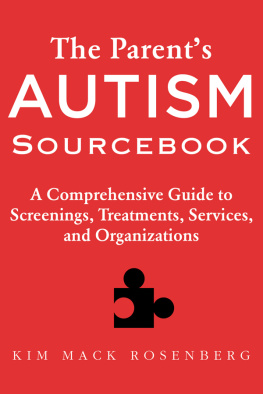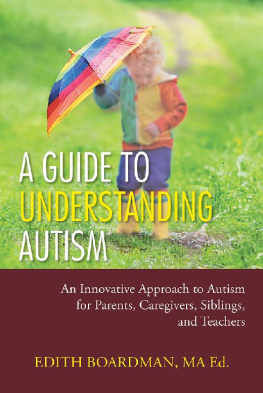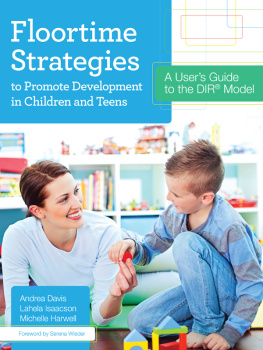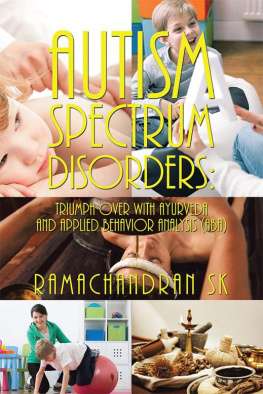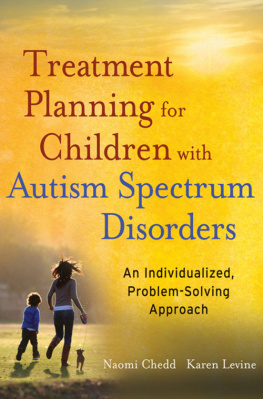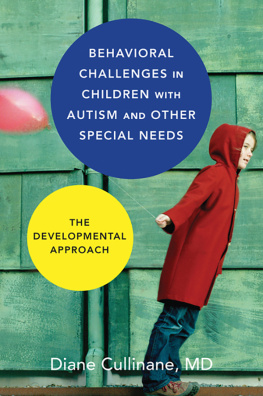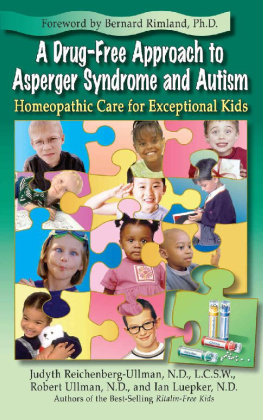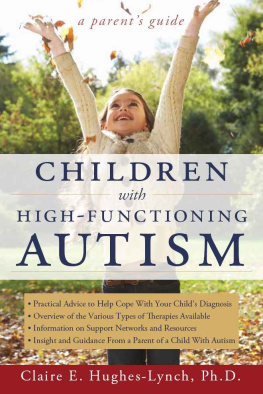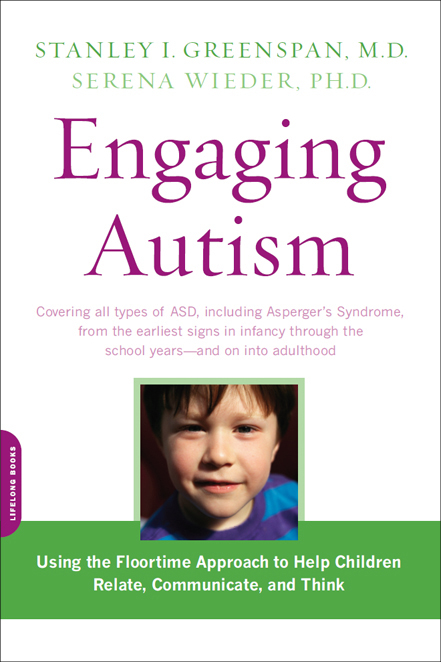
Engaging Autism
Engaging
Autism
Using the Floortime Approach to Help
Children Relate, Communicate, and Think

STANLEY I. GREENSPAN, M.D.
SERENA WIEDER, PH.D.

A Merloyd Lawrence Book
DA CAPO LIFELONG BOOKS
A Member of the Perseus Books Group
Many of the designations used by manufacturers and sellers to distinguish their products are claimed as trademarks. Where those designations appear in this book and Da Capo Press was aware of a trademark claim, the designations have been printed in initial capital letters.
Copyright 2006 by Stanley I. Greenspan, M.D.
All rights reserved. No part of this publication may be reproduced, stored in a retrieval system, or transmitted, in any form or by any means, electronic, mechanical, photocopying, recording, or otherwise, without the prior written permission of the publisher.
Note: The information in this book is true and complete to the best of our knowledge. This book is intended only as an informative guide for those wishing to know more about health issues. In no way is this book intended to replace, countermand, or conflict with the advice given to you by your own physician. The ultimate decision concerning care should be made between you and your doctor. We strongly recommend you follow his or her advice. Information in this book is general and is offered with no guarantees on the part of the authors or of Da Capo Press. The authors and publisher disclaim all liability in connection with the use of this book. The names and identifying details of people associated with events described in this book have been changed. Any similarity to actual persons is coincidental.
Designed by Trish Wilkinson
Set in 11.5-point Goudy by The Perseus Books Group
Library of Congress Cataloging-in-Publication Data
Greenspan, Stanley I.
Engaging autism : using the floortime approach to help children relate, communicate, and think / Stanley I. Greenspan, Serena Wieder.
p. cm.
Includes bibliographical references and index.
ISBN-13: 978-0-7382-1137-4
1. Autistic childrenBehavior modification. 2. Autistic childrenRehabilitation. 3. Autistic childrenEducation. 4. Parents of autistic children. I. Wieder, Serena. II. Title.
RJ506.A9G74 2006
618.9285882dc22
2006001814
First Da Capo Press edition 2006
First Da Capo Press paperback edition 2009
A Merloyd Lawrence Book
Published by Da Capo Press
A Member of The Perseus Books Group
http://www.dacapopress.com
Da Capo Press books are available at special discounts for bulk purchases in the U.S. by corporations, institutions, and other organizations. For more information, please contact the Special Markets Department at the Perseus Books Group, 2300 Chestnut Street, Suite 200, Philadelphia, PA 19103, or call (800) 810-4145, ext. 5000, or email .
10 9 8 7 6 5 4 3 2 1
Acknowledgments
W e want to thank Deirdre Schwiesow for her extraordinary sensitivity, talent, and dedication in facilitating the writing and editing of this work. We also want to thank Jan Tunney and Sarah Miller for their very helpful administrative support. A special thanks goes to Merloyd Lawrence for her gifted editing and suggestions.
Most of all, we want to thank the children and families who have allowed us to be members of their teams and who have worked so hard to overcome developmental challenges. Their dedication and creativity are a source of inspiration for the ideas in this work.
Contents
W hen the pediatrician told Marissa that her beautiful son Sean was autistic, her heart sank to the floor. It took days for Marissa and her husband, John, to confront this diagnosis and to realize its dramatic implications for their beloved, bright-eyed two-year-old child and for their own life together. When they did, and after they had done some research on autism and autistic spectrum disorders (ASDs), the weight in their hearts did not lighten. The information about ASD they gleaned from books and from the Internet was overwhelming, with many different points of view and treatment options. They had to learn a whole new vocabulary just to understand what was going on with Sean, and in the midst of their grief at the diagnosis, they found this very hard to do. Most disturbing of all, they werent sure they were getting the right advice on how to treat their son. They wanted a treatment program that would give him the best possible chance to make progress and, they hoped, experience friendship, school, birthday parties, dating, sports, college, a career, and someday, having and raising children of his own.
The first specialist whom Marissa and John consulted told the couple that Sean would probably never be able to relate to other peoples feelings or to think creatively. The best they could expect was for Sean to learn to behave in socially acceptable ways through a treatment approach that focused on his symptoms and behavior. For example, he could learn to memorize scripted phrases to say to another child, and his parents could encourage him to make eye contact with them by rewarding him with food. In the face of this advice, the couple felt hopeless and helpless. They believed their son had more potential than that, and they wanted him to want to relate to them and to think for himself.
Many parents of children diagnosed with ASD feel like Marissa and John. They want a program that will consider their child as an individual, offer personalized treatment, and unleash the childs potential for meaningful communication and relationships. Such parents also want to be a part of their childs treatment plan. They want to help and to hope. This book is written with such parentsand their childrens other caregiversin mind. It presents an approach that can fundamentally change assumptions about autism and ASD and vastly improve the outlook for children with these disorders.
For sixty years, treatments for ASD have focused on the symptoms of the condition, rather than on the underlying problems. As a result, goals for individual children have often been limited to changes in behavior, and the long-term prognosis for many children with the disorder has been deeply pessimistic. Prevailing assumptions about the nature of autism have limited the kind of progress and future expected for these children.
Estimates for the number of children with some form of ASD range as high as 1 in 166. Better futures are now possible for these children. With a comprehensive, individualized approach to assessment and treatment that focuses on the building blocks of healthy development, as described in the following chapters, many children diagnosed with ASD have made progress that goes far beyond what is traditionally described as high functioning. The formal name for this new approach is the developmental, individual-difference, relationship-based (DIR) model. It is also often referred to as the Floortime approach. Floortime is actually a basic strategy within the DIR model. This book explains the DIR approach for parents, professionals, and other caregivers of children with ASD.
The goal of treatment within the DIR/Floortime model is to build foundations for healthy development, rather than to work only on surface behavior and symptoms. With this approach, children learn to master critical abilities missed or derailed along their developmental pathnamely, the ability to relate to others with warmth and pleasure, communicate purposefully and meaningfully (first with gestures and then often with words), and, to varying degrees, think logically and creatively. A significant number of children treated in this way have broken new ground, mastering abilities formerly thought unattainable by children with ASD. They have formed warm, intimate relationships with family and peers and have developed sophisticated verbal skills. They not only have mastered academics but also intellectual skills, such as spontaneous thinking, making and understanding inferences, and empathizing with others.
Next page

